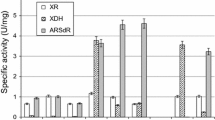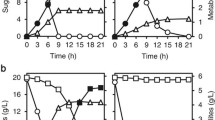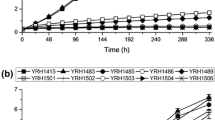Abstract
To improve the ability of recombinant Saccharomyces cerevisiae strains to utilize the hemicellulose components of lignocellulosic feedstocks, the efficiency of xylose conversion to ethanol needs to be increased. In the present study, xylose-fermenting, haploid, yeast cells of the opposite mating type were hybridized to produce a diploid strain harboring two sets of xylose-assimilating genes encoding xylose reductase, xylitol dehydrogenase, and xylulokinase. The hybrid strain MN8140XX showed a 1.3- and 1.9-fold improvement in ethanol production compared to its parent strains MT8-1X405 and NBRC1440X, respectively. The rate of xylose consumption and ethanol production was also improved by the hybridization. This study revealed that the resulting improvements in fermentation ability arose due to chromosome doubling as well as the increase in the copy number of xylose assimilation genes. Moreover, compared to the parent strain, the MN8140XX strain exhibited higher ethanol production under elevated temperatures (38 °C) and acidic conditions (pH 3.8). Thus, the simple hybridization technique facilitated an increase in the xylose fermentation activity.




Similar content being viewed by others
References
Banat IM, Nigam P, Singh D, Marchant R, McHale AP (1998) Ethanol production at elevated temperatures and alcohol concentrations: Part I—yeasts in general. World J Microbiol Biotechnol 14:809–821
Bruinenberg PM, Debot PH, van Dijken JP, Scheffers WA (1983) The role of redox balances in the anaerobic fermentation of xylose by yeasts. Eur J Appl Microbiol Biotechnol 18:287–292
de Godoy LMF, Olsen JV, Cox J, Nielsen ML, Hubner NC, Fröhlich F, Walther TC, Mann M (2008) Comprehensive mass-spectrometry based proteome quantification of haploid versus diploid yeast. Nature 455:1251–1255
Ding MZ, Li BZ, Cheng JS, Yuan YJ (2010) Metabolome analysis of differential responses of diploid and haploid yeast to ethanol stress. OMICS 14:553–561
Eliasson A, Christensson C, Wahlbom CF, Hahn-Hägerdal B (2000) Anaerobic xylose fermentation by recombinant Saccharomyces cerevisiae carrying XYL1, XYL2, and XKS1 in mineral medium. Appl Environ Microbiol 66:3381–3386
Elion EA (2000) Pheromone response, mating and cell biology. Curr Opin Microbiol 3:573–581
Fonseca GG, Heinzle E, Wittmann C, Gombert AK (2008) The yeast Kluyveromyces marxianus and its biotechnological potential. Appl Microbiol Biotechnol 79:339–354
Garay-Arroyo A, Covarrubias AA, Clark I, Niño I, Gosset G, Martinez A (2004) Response to different environmental stress conditions of industrial and laboratory Saccharomyces cerevisiae strains. Appl Microbiol Biotechnol 63:734–741
Hashimoto S, Aritomi K, Minohara T, Nishizawa Y, Hoshida H, Kashiwagi S, Akada R (2006) Direct mating between diploid sake strains of Saccharomyces cerevisiae. Appl Microbiol Biotechnol 69:689–696
Hasunuma T, Sanda T, Yamada R, Yoshimura K, Ishii J, Kondo A (2011) Metabolic pathway engineering based on metabolomics confers acetic and formic acid tolerance to a recombinant xylose-fermenting strain of Saccharomyces cerevisiae. Microb Cell Fact 10:2
Higgins VJ, Bell PJL, Dawes IW, Attfield PA (2001) Generation of a novel Saccharomyces cerevisiae strain that exhibits strong maltose utilization and hyperosmotic resistance using nonrecombinant techniques. Appl Environ Microbiol 67:4346–4348
Katahira S, Mizuike A, Fukuda H, Kondo A (2006) Ethanol fermentation from lignocellulosic hydrolysate by a recombinant xylose- and cellooligosaccharide-assimilating yeast strain. Appl Microbiol Biotechnol 72:1136–1143
Kötter P, Ciriacy M (1993) Xylose fermentation by Saccharomyces cerevisiae. Appl Microbiol Biotechnol 38:776–783
Leu JY, Murray AW (2006) Experimental evolution of mating discrimination in budding yeast. Curr Biol 16:280–286
Li BZ, Cheng JS, Ding MZ, Yuan YJ (2010) Transcriptome analysis of differential responses of diploid and haploid yeast to ethanol stress. J Biotechnol 148:194–203
Martin C, Jönsson LJ (2003) Comparison of the resistance of industrial and laboratory strains of Saccharomyces and Zygosaccharomyces to lignocellulose-derived fermentation inhibitors. Enzyme Microb Technol 32:386–395
Nevoigt E (2008) Progress in metabolic engineering of Saccharomyces cerevisiae. Microbiol Mol Biol Rev 72:379–412
Pasha C, Kuhad RC, Rao LV (2007) Strain improvement of thermotolerant Saccharomyces cerevisiae VS3 strain for better utilization of lignocellulosic substrates. J Appl Microbiol 103:1480–1489
Runquist D, Fonseca C, Radstrom P, Spencer-Martins I, Hahn-Hägerdal B (2009) Expression of Gxf1 transporter from Candida intermedia improves fermentation performance in recombinant xylose-utilizing Saccharomyces cerevisiae. Appl Microbiol Biotechnol 82:123–130
Saloheimo A, Rauta J, Stasyk OV, Sibirny AA, Pentillä M, Ruohonen L (2007) Xylose transport studies with xylose-utilizing Saccharomyces cerevisiae strains expressing heterologous and homologous permeases. Appl Microbiol Biotechnol 70:6816–6825
Tajima M, Nogi Y, Fukasawa T (1985) Primary structure of the Saccharomyces cerevisiae GAL7 gene. Yeast 1:67–77
van Vleet JH, Jeffries TW (2009) Yeast metabolic engineering for hemicellulosic ethanol production. Curr Opin Biotechnol 20:300–306
Yamada R, Tanaka T, Ogino C, Kondo A (2010a) Gene copy number and polyploidy on products formation in yeast. Appl Microbiol Biotechnol 88:849–857
Yamada R, Tanaka T, Ogino C, Kondo A (2010b) Novel strategy for yeast construction using δ-integration and cell fusion to efficiently produced ethanol from raw starch. Appl Microbiol Biotechnol 85:1491–1498
Yan F, Bai F, Tian S, Zhang J, Zhang Z, Yang X (2009) Strain construction for ethanol production from dilute-acid lignocellulosic hydrolysate. Appl Biochem Biotechnol 157:473–482
Yoshida S, Imoto J, Minato T, Oouchi R, Sugihara M, Imai T, Ishiguro T, Mizutani S, Tomita M, Soga T, Yoshimoto H (2008) Development of bottom-fermenting Saccharomyces strains that produce high SO2 levels, using integrated metabolome and transcriptome analysis. Appl Environ Microbiol 74:2787–2796
Acknowledgements
The authors would like to thank Ms. Yoshimi Hori for technical assistance. This work has been supported by the Project P07015 administered by the New Energy and Industrial Technology Development Organization (NEDO) under the sponsorship of the Ministry of Economy, Trade, and Industry (METI) of Japan. This work was also supported by Grants-in-Aid for Young Scientists (B) to TH from the Ministry of Education, Culture, Sports, and Technology (MEXT) of Japan and a Special Coordination Funds for Promoting Science and Technology, Creation of Innovative Centers for Advanced Interdisciplinary Research Areas (Innovative Bioproduction Kobe), MEXT, Japan.
Author information
Authors and Affiliations
Corresponding author
Electronic supplementary material
Below is the link to the electronic supplementary material.
ESM 1
(DOCX 60 kb)
Rights and permissions
About this article
Cite this article
Kato, H., Suyama, H., Yamada, R. et al. Improvements in ethanol production from xylose by mating recombinant xylose-fermenting Saccharomyces cerevisiae strains. Appl Microbiol Biotechnol 94, 1585–1592 (2012). https://doi.org/10.1007/s00253-012-3914-6
Received:
Revised:
Accepted:
Published:
Issue Date:
DOI: https://doi.org/10.1007/s00253-012-3914-6




